(219 products available)

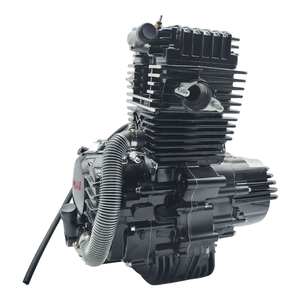










































































































































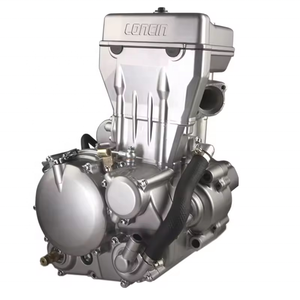
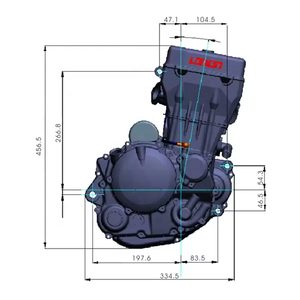
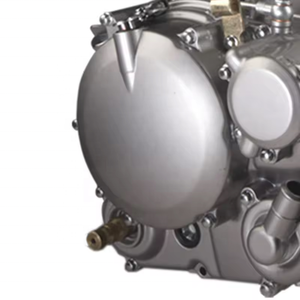
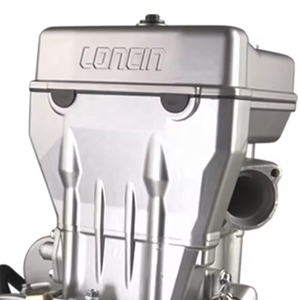
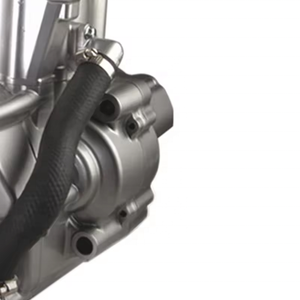
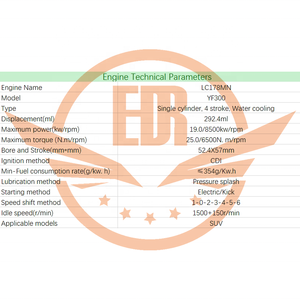







































Lifan 300 cc single-cylinder four-stroke engines:
This Lifan 300 cc engine is also called a Lifan 300 cc bike engine. It has a 300 cc capacity and uses four strokes: intake, compression, power, and exhaust. During the intake stroke, the piston moves down the cylinder, and air and fuel enter the cylinder through open valves. In the compression stroke, both valves close, and the piston moves up to compress the air and fuel. The candles ignite the compressed mixture during the power stroke, pushing the piston down. Lastly, the exhaust stroke sees the piston moving up again, and the exhaust valves open to release the burnt gases. These engines are popular in motorcycles due to their higher power output and efficiency.
Lifan 300 cc parallel-twin four-stroke engines:
Lifan 300 cc parallel-twin four-stroke engines have two cylinders arranged side by side. Each cylinder goes through the same four-stroke process as the single-cylinder engines. These engines have a higher power output and smoother operation than the single-cylinder engines. The parallel twin-cylinder design allows for more power without increasing the engine size.
Lifan 300 cc four-cylinder engines:
Lifan 300 cc four-cylinder engines have four cylinders in a line. Each cylinder has its four-stroke cycle, like the parallel-twin engines. The four-cylinder design gives even more power and smoother running. Lifan 300 cc four-cylinder engines produce more power and are used in vehicles that require more power, like small cars.
Lifan 300 cc liquid-cooled engines:
These engines use liquid cooling systems to maintain the optimal engine temperature. The liquid cooling system has a water pump, radiator, and hoses that carry the coolant. The coolant circulates through the engine to absorb heat and then goes to the radiator. The radiator releases the heat, and the coolant returns to the engine.
Lifan 300 air-cooled engines:
Lifan 300 air-cooled engines use air to cool the engine. The engine is designed so that the moving parts get direct wind from the bike or the vehicle. These engines are not as effective as the liquid-cooled engines, and they are mostly used in older models.
Oil changes
The engine oil lubricates the Lifan 300cc engine parts to minimize wear and tear. However, over time, the oil breaks down and becomes less effective. Perform regular oil changes as per the manual recommendation. This is usually every 3000 to 5000 miles. The oil change is important because it helps maintain proper engine lubrication.
Air filter replacement
The engine relies on clean air for optimal performance. Thus, it is important to check the air filter every month. A clogged air filter restricts airflow, causing the engine to work harder. This wastes fuel. Replace the air filter every 15,000 miles or sooner in dusty conditions.
Coolant level inspection
The liquid coolant prevents overheating of the engine. Inspect the reservoir monthly to ensure the coolant is at the recommended level. Also, check for any leaks. A low coolant level can damage the engine.
Valve clearance adjustment
The engine valves regulate airflow. Their timing requires precise adjustment. The valve clearance should be checked and adjusted after 6000 miles or as per the manual schedule. This ensures the valves function properly and maximizes engine efficiency.
Spark plug inspection
Spark plugs ignite the fuel-air mixture in the engine. They should be inspected every 10,000 miles or at intervals recommended in the manual. The spark plugs are checked for wear and replaced as needed. This helps maintain optimal combustion and engine power.
Tire rotation and suspension check
The tires are rotated every 5000 miles for even tread wear. The suspension components such as shocks and struts are also inspected. Worn tires or suspension parts can affect ride quality and engine efficiency.
Choosing the right Lifan 300cc engine can be challenging, but it doesn't have to be. Here are some tips and tricks to help make the decision easier:
As the Lifan 300cc engine is a complex machine, at some point, the engine will need to be replaced. When this happens, it is important to have a qualified mechanic do the replacement. However, if the user has mechanical knowledge of the engine, they can follow the steps below to replace the engine.
Before beginning the process, ensure to have the following tools:
Step-by-step guide:
Q1: How often should the Lifan engine be serviced?
A1: The service interval for the Lifan engine depends on the engine's running conditions and the oil used. Generally, it is recommended to service every 5000km or every six months. However, for more demanding conditions such as frequent short trips, heavy load, or high-temperature environments, more frequent services are required.
Q2: What type of fuel should be used for the Lifan engine?
A2: Most Lifan 300cc engines require gasoline with an octane rating of 90 or higher. Using fuel with a lower octane rating can affect engine performance and may cause knocking. It is best to refer to the owner's manual for detailed fuel requirements.
Q3: How can engine performance be improved?
A3: In addition to regular maintenance, using high-quality engine oil, clean air and fuel filters, and high-quality spark plugs can help improve engine performance. Also, maintaining proper tire pressure and not overloading the vehicle can help improve engine performance.
Q4: What should be done if the engine has performance issues?
A4: If the engine has performance problems, it is best to take it to a Lifan service center or a qualified mechanic for inspection and repair. They have the necessary tools and expertise to diagnose and fix engine problems.
Q5: Can engine performance be improved by modifying the engine?
A5: Although engine modification can improve engine performance, it is not recommended because it can affect the vehicle's reliability, safety, and compliance with emission standards. In addition, engine modification may void the vehicle's warranty. If a higher engine performance level is required, it is advisable to consult a Lifan dealer for other options.